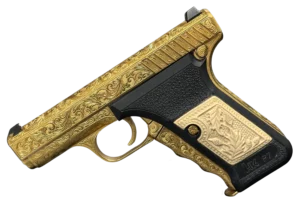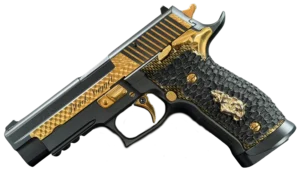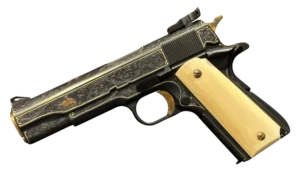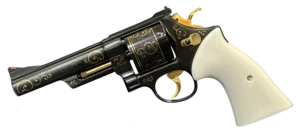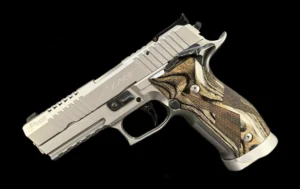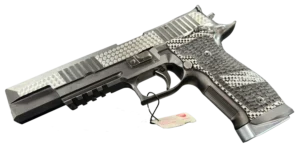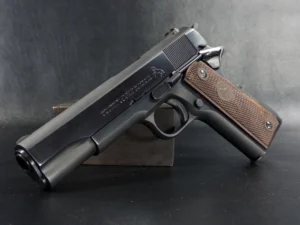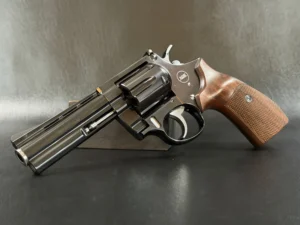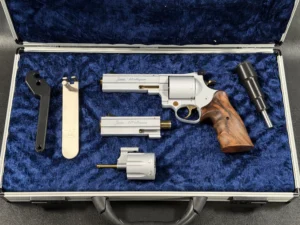Key Takeaways:
- More Than Function: Mueller Murgenthal’s firearms, daggers, and sculptures transcend their categories—each is a fully realized work of art built for legacy, not mass production.
- A Legacy in Limited Numbers: Every Mueller piece is intentionally rare—often one of one—crafted with obsessive attention to detail and meant to be handed down, not traded up.
- Royal-Caliber Craftsmanship: From palaces to private collections, Mueller’s creations rival Fabergé in artistry, offering collectors an emotional connection to something timeless, tactile, and quietly powerful.
The Name You Didn’t Know You Needed to Know
Ever heard of Mueller Murgenthal?
Chances are, unless you move in elite collector circles or spend your weekends flipping through obscure art catalogs, the name might not ring a bell. And that—if we’re being honest—is part of the mystery. Part of the magic.
Mueller Murgenthal isn’t a brand that screams for attention. It doesn’t show up on billboards or roll off the tongues of lifestyle influencers. It exists in whispers, passed between collectors with a reverent nod, like a well-kept secret shared behind velvet ropes.
But make no mistake—what they create is unforgettable.
This Swiss atelier crafts everything from Fabergé-level sculpture to royal-grade daggers to custom firearms that straddle the line between lethal precision and fine art. They’re artisans in the purest, almost forgotten sense of the word. With every engraving, every polished surface, they tell a story. One that’s sharp, elegant, and rare enough to make your breath catch.
So why are we just now talking about them?
Because some things aren’t meant to be mass-marketed—they’re meant to be discovered, cherished, and, if you’re lucky, inherited.
A Small Swiss Town with a Loud Legacy
You’ll find Murgenthal tucked into the rolling hills of Switzerland. It’s not the sort of place that demands attention—no grand skyline, no international airport, no glossy tourist brochure shouting its name. Just a quiet town where the rhythm of life hasn’t changed much in a hundred years.
But from that quiet emerges something extraordinary.
Mueller Murgenthal was born in this hushed landscape, rooted in a region known more for pastoral beauty than precision artistry. Yet the Swiss have always had a curious way of making noise without ever raising their voices. Think about it—watches, chocolate, banking, knives. Everything is meticulous and exacting, yet it remains both understated and of world-class quality.
Mueller followed that same path. But instead of ticking mechanisms or creamy confections, they chose silver, steel, and soul as their mediums.
They didn’t just make art. They made a legacy.
The Silversmith’s Soul: Sculptures That Breathe
Now, here’s where things get interesting.
Mueller Murgenthal began with silversmithy. Not the dainty, predictable sort you find gathering dust on a forgotten mantelpiece. Their work had a pulse. Weight. Something that pulled you in before you even understood what you were looking at.
Their sculptures live somewhere between the sacred and the cinematic. Imagine a falcon mid-dive, wings flared in hammered silver. Or a lion’s head cast in obsidian bronze, mane rippling as if wind had just passed through the room. These aren’t static decorations—they feel alive.
What’s wild is how they play with light. One moment, you’re seeing hard edges, bold structure. Next, your eyes catch a soft gleam, and suddenly it’s fluid—melting, reshaping, coming alive in your mind’s eye. It’s almost theatrical.
There’s something undeniably human about that, isn’t there? The way beauty flickers, the way emotion catches us off guard.
That’s what Mueller does with metal. They make it emotional.
And sure, other sculptors have done this—think Auguste Rodin or Alberto Giacometti. But Mueller adds a layer of intimacy. You don’t stand in front of a Mueller piece. You stand with it.
Art You Can Chamber: Firearms Beyond Function
Alright, let’s talk about the elephant in the room.
Yes, Mueller Murgenthal makes firearms. But before your mind jumps to tactical gear and shooting ranges, let’s hit the brakes.
Because these are not your run-of-the-mill pistols. They’re not even luxury guns in the typical sense. These are mechanical symphonies—functioning artworks you could holster if you dared.
Their firearms often feature scrollwork that rivals 19th-century engravers, hand-inlaid gold filigree, and rare hardwood grips polished to a mirror sheen. Every screw, every curve, every subtle weight distribution is intentional. There’s history in the metallurgy and poetry in the balance.
Some call them presentation pieces. Others call them heirlooms.
Collectors? They just call them irreplaceable.
Take one of their custom P210 pistols, for instance. Yes, it fires with surgical precision. But it also looks like something that should be displayed in the Louvre, not a locked cabinet. And there’s the paradox—beauty that was built for use but destined for reverence.
It’s like owning a Stradivarius. You can play it, but should you?
Blades Fit for a Throne: Daggers as Decorative Diplomacy
There’s something about a dagger that immediately commands respect.
Maybe it’s the shape—clean, elegant, purposeful. Maybe it’s the history—every culture on earth has held the dagger as both a symbol of power and a tool of personal honor. Whatever it is, Mueller Murgenthal has mastered that ancient language in a way that feels… well, royal.
Their daggers aren’t mass-produced, and they certainly aren’t just for show. These are ceremonial weapons that feel like they’ve stepped straight out of a monarch’s armory. You’ll find blades forged from pattern-welded Damascus steel so mesmerizing it practically ripples under soft light. Handles carved from rare materials—walrus ivory, ebony wood, polished horn—each one shaped to fit a human hand but too beautiful to wield in anything but reverence.
Mueller’s dagger commissions have ended up in places you’d expect—palaces, embassies, private vaults. Some have been gifted to kings. Others passed from one diplomat to another as a sign of trust, legacy, and elegance.
There’s something undeniably intimate about it. A dagger isn’t like a sword—it’s not for battlefield flair. It’s for moments up close, both in history and design.
And Mueller captures that intimacy. Every curve, every balance point, every engraving—it all whispers the same message:
“This is not a weapon. This is a message in metal.”
The Art of Constraint: Limited Pieces, Unlimited Emotion
Here’s the thing most people miss when they talk about luxury: it’s not always about price. It’s about rarity. About knowing that what you own is truly, almost impossibly, one-of-a-kind.
Mueller Murgenthal gets that in their bones.
They don’t operate a factory. They don’t “release collections.” There are no limited editions hyped up in press kits or plastered across social media. Instead, they work like storytellers. Quietly. Carefully. Patiently.
Each piece—whether it’s a sculpture, a firearm, or a ceremonial dagger—is often the only one of its kind. Or maybe one of two. Sometimes a trio, but never a dozen.
It’s not scarcity for marketing’s sake. It’s a deep respect for time, effort, and individuality. When you see a Mueller piece, you’re seeing hundreds of hours of thought, labor, sketching, failing, refining. And maybe—just maybe—you’ll never see it again.
It creates something strange and beautiful: emotional weight.
Collectors often talk about the feeling of holding one of these works. It’s not just pride. It’s a responsibility. You don’t just own a Mueller—you’re keeping it safe for the next century. You’re part of its story now.
And that kind of connection? That’s priceless.
More Than Fabergé Envy: Mueller’s Place Among the Greats
At this point, it’s only natural to think of the classics—Fabergé, Tiffany, Lalique, Boucheron. Giants in the world of fine art and object-making. And truth be told, Mueller Murgenthal shares that echelon, though they rarely claim the spotlight.
But here’s where it gets interesting.
Where Fabergé eggs are celebrated for their elaborate, almost fantastical opulence, Mueller’s work often feels grounded, rooted in tradition, yet never stuck in it. Their pieces have gravity. They feel storied. A bit more steel, a little less sparkle—but every bit as breathtaking.
In fact, it’s not uncommon to find a Mueller firearm or sculpture nestled between Cartier watches and Fabergé objets d’art in a high-end private collection. Not because it was designed to compete with them, but because it stands on its own, uncompromising in its materials and meaning.
It’s apples and oranges. Or maybe apples and obsidian—both exquisite, but only one could leave a mark on stone.
If Fabergé’s works were love letters to imperial elegance, Mueller’s are quiet hymns to permanence.
For Collectors, Connoisseurs, and the Quietly Obsessed
Let’s get real for a second.
People who collect Mueller Murgenthal’s work? They aren’t seeking bragging rights or following trends for investment potential, even though these pieces often appreciate significantly.
They’re looking for something they can feel.
It’s the kind of person who runs their fingers across a cold metal sculpture and sees not just craftsmanship but memory. Someone who appreciates not just the end product, but the soul baked into every polished surface and hand-cut line.
You don’t just stumble into owning a Mueller. You arrive at it through passion, curiosity, and, frankly, luck.
Some get their first piece through auction houses, sometimes unnamed and tucked away under vague listings like “Swiss Engraved Dagger, Early 20th Century.” Others inherit them. And a few—the lucky few—commission them directly. Those commissions? They can take years. But once delivered, they become family treasures.
The kind of object your grandchildren will fight over.
What’s in a Name? A Legacy Still Unfolding
So, let’s go back to that name—Mueller Murgenthal.
It’s not trending on Instagram. There’s no flashy showroom in Paris. You won’t find merch or pop-up galleries. And that’s exactly the point.
The name isn’t designed to be popular. It’s designed to mean something.
It represents tradition and patience, requiring hundreds of hours dedicated to a single object, often unnoticed and uncelebrated. And it means knowing that not everything of value needs to shout.
Some names speak softly. Mueller Murgenthal is one of them.
But those who know? They hear it loud and clear.
The Signature You Can’t Replicate
Let’s not overcomplicate this.
Mueller Murgenthal doesn’t just make beautiful things. They make things that feel inevitable. Like they were always meant to exist, and it just took the right artist to pull them from the ether into form.
Their work spans metal and myth, sculpture and story. Some parts have sharp edges. Others shine brightly. Some provide protection. All are interconnected.
If you’re lucky enough to see one up close—really see it—you’ll get it. That pulse. That silence. That strange sensation of looking at something you can’t quite explain, but somehow understand.
It encompasses more than just art, weaponry, or craftsmanship.
It’s Mueller.
And there’s nothing else like it.
Frequently Asked Questions
Mueller Murgenthal is a discreet but legendary Swiss workshop known for crafting ultra-luxury sculptures, presentation-grade firearms, and ceremonial daggers. They’re intentionally low-profile, catering to elite collectors and dignitaries through word-of-mouth and private commissions.
Yes—fully. Mueller firearms are built to exacting standards of mechanical performance. But let’s be honest: most owners display them as treasured art pieces, not range gear.
Think Damascus steel, sterling silver, gold inlay, mother-of-pearl, rare hardwoods, and sometimes even fossilized materials. Every choice is purposeful and often symbolic.
Not at all. While Mueller is best known for firearms and daggers, their sculptures—often animals, mythical figures, or abstract forms—are masterful blends of metalwork and fine art.
Fabergé celebrated imperial whimsy; Mueller channels aristocratic gravity. While the aesthetic differs, the dedication to detail, emotion, and legacy places Mueller in the same league, just with a more restrained, steel-toned voice.



